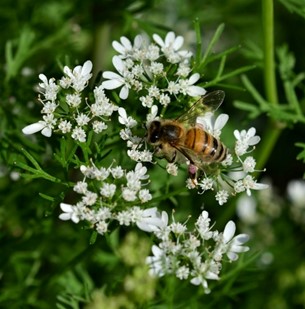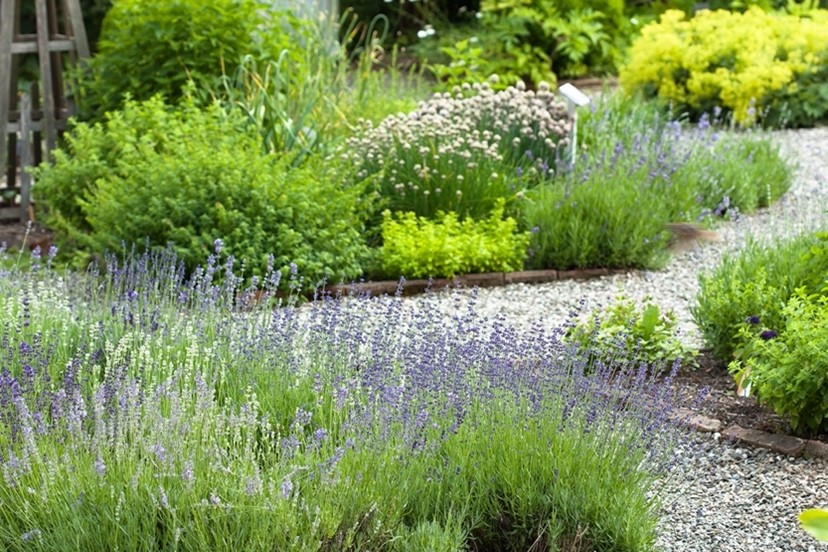Herb Selections for the Kitchen Garden
- 2023-05-04
- By mkirk
- Posted in The Garden Buzz
By Judy Kunz, Colorado Master Gardener

Photo: https://www.allaboutgardening.com/herbs-beneficial-insects/
Easy to grow and rewarding to harvest, herbs have been perennial favorites of gardeners around the world dating back thousands of years. Evidence of ancient Egyptians propagating herbs for decorative, culinary and medicinal uses was recorded over 3,000 years ago. Most of today’s popular herbs come from the Mediterranean and are used in cooking and as common ingredients in cosmetics, perfumes, dyes, dental preparations and insect repellents.
Herbs can enhance the flavor of a favorite recipe and demand relatively little effort in terms of care. They can be tucked into corners of the vegetable garden, grown in their own space in a separate spiral herb garden, or planted in pots on a patio or deck. Most herbs are best used fresh, but many can be dried and preserved for later use. Herbs from the garden make great gifts, and propagating them is also a benefit to the environment because they attract a variety of pollinators.
Most herbs need a minimum of six hours of sunlight and prefer damp, well-drained, loamy soil. Adding 5-7% organic matter in the form of compost or leaf mold to the native soil before planting will enhance their performance. Because flowering requires a plant to direct its energy toward reproduction, many herbs taste best if their blossoms are pinched off as buds appear. Protect perennial herbs during the winter with a layer of straw and water occasionally during warm, snowless periods.

Photo: Nancy Kennedy
The list below includes ten popular herbs with cultural recommendations in italics:
Chives are the smallest member of the onion family. All parts of the chive plant are edible, including the blossoms. They also make an attractive border in a flower garden. (Perennial, full to part sun, moist soil but not wet.)
Cilantro belongs to the carrot family. Both the leaves and mature seeds (coriander) can be harvested. Use young leaves before flowering for maximum flavor, while seeds ripen after flowering. Hot weather can cause early bolting. (Annual, full sun to part shade, moist, well-draining soil.)
Dill can be sown several times during the growing season. Both the fern-like leaves and seeds can be used. It can bolt early in hot weather. (Annual, full sun, moist, well-draining soil.)
Mint is an aggressive plant that spreads through rhizomes (underground horizontal stems). It can become invasive, so plant it in a separate area to keep it in check or plant it in a pot. It’s generally pest free. Mint flowers are edible but milder tasting than the leaves. (Perennial, part shade, moist, well-draining soil.)
Oregano spreads through rhizomes. Leaves are best used after drying. It is generally heat tolerant. (Perennial, full sun, can tolerate dryer conditions.)
Parsley is a popular member of the carrot family that enhances many dishes. It is also a breath sweetener. It’s best to use parsley fresh as it loses flavor when dried. (Biennial, light shade, moist, well-draining soil.)
Rosemary is another member of the mint family. Avoid over watering to prevent root rot. It doesn’t survive our winters in zone 5b but it can be kept indoors on a sunny window ledge. (Annual, full sun, dryer, well-draining soil.)
Sage is a member of the mint family that prefers a somewhat drier location. Harvest leaves moderately during the first year to allow roots to fully develop. (Perennial, full sun, dryer, well-draining soil.)
Tarragon is a drought tolerant member of the daisy family. Cut down in the fall to the base of the plant. (Perennial, full sun, dryer, well-draining soil.)
Thyme is another member of the mint family. It prefers moist soil but can handle drier conditions. To prevent root rot, don’t over water. (Perennial, full sun, moist to dry well-draining soil.)
For more details on herb selection, planting and care see: https://cmg.extension.colostate.edu/Gardennotes/731.pdf
Horticulture Resources
- Garden Buzz Archives
- CSU Extension Resources
- Colorado Master Gardener Program
- Foothills to Plains Native Plant Master Program
- Native Bee Watch Community Science Program
- The Co-Hort Blog
- PlantTalk Colorado
- Soil Testing
- Plant Select
- Emerald Ash Borer
- Japanese Beetle
- Colorado State Forest Service
- Ask an Expert


